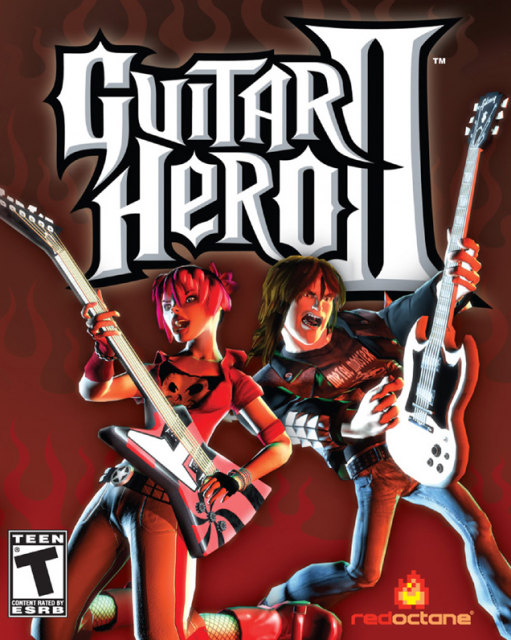"Though my eyes could see I still was a blind man..."
When I first saw the videos and buzz about Guitar Hero in late 2005, I was intrigued. A year later I asked for a PlayStation 2 for Christmas and Guitar Hero was the first thing I thought of. However, its sequel Guitar Hero II had just come out and so I asked for that instead. When I opened my presents that morning and popped GHII into my new system, I could not have been more satisfied, because Guitar Hero II is a totally awesome game and a blast to play.
To be frank, this game rocks. Rhythm games have never been anything special to me before, but Guitar Hero II's custom-shaped controller makes all the difference in the world. If you’ve never seen the controller, it’s shaped just like a real electric guitar but smaller in size. The neck has five colored fret buttons; green, red, yellow, blue and orange. To actually play notes, you hold down the corresponding color fret button and “strum” on the click-flipper that fills in for the strings. For those of you who would like to get more immersed in the guitar-playing fantasy, there is even a whammy bar that can warble longer notes (and increase you Star Power meter, but more on that later). It takes some getting used to, but after a little practice you'll be hitting the fret buttons like it was second nature.
There's no real "story," but what passes for one is that you (you choose one of eight avatars and can customize their appearance with unlockable outfits and guitars) are an up-and-coming guitarist making your way up the ladder on the national underground music circuit. That's where the game really stops caring because that's where you should stop caring. However, to immerse you in the fantasy of playing in a band the game does a very good job of creating atmosphere. The venues play the biggest part in this; as you descend down the list of songs you unlock bigger and bigger places to play in with corresponding cheering crowds. From a school gym to a local bar, a concert hall, the Vans Warped Tour and even Stonehenge, the venue gets huger and more immersive the further you progress, but that’s just the beginning.
Guitar Hero II is about the music and there's plenty of it. There are up to 40 songs in Career mode (only 28 in Easy, Medium and up get all 40) with another 24 unlockable songs you can buy with in-game money. You can get a score of 3 to 5 stars in a song, and depending on how well you play a song you're given money which you can then spend on new songs, new characters, new guitars and other things. How well you play a song is graded on things like longest note streak and average score multiplier throughout the song, but also heavily on your final score. For a multiplier, hit ten notes in a row to have notes double in value from 50 to 100 (x2), then another ten for 100 to 150 (x3), and finally another ten for 150 to 200 (x4). But remember, you have to actually finish the song! You can't just play terribly and get away with it, for you will be punished (with the crowd booing and your amp giving you horrible feedback, for example). This is where Star Power comes in.
Star Power is earned by playing enough star-shaped notes throughout the song to fill up a blue bar on the right of the screen above your odometer-like “Rock Meter”. Depending on how well you are playing your Rock Meter will be in Red, Yellow or Green. When you're in the Green, you're hitting most notes and the crowd loves you, but mess up enough to get down to Yellow and then Red and the crowd may become hostile. Once your Star Power meter is full enough you can tilt the guitar to point up (or press Select if you're fast enough) and all notes will glow blue, doubling your score multiplier (up to x8, or 400 points per note) and (important for a hard song) the crowd will start loving you if you hit enough notes, which is important because the crowd’s love dictates whether or not you will even pass the song.
I noted earlier that your whammy bar helps you with Star Power, so let’s delve into that. There are two types of notes, short and long. Short notes are most common; you just press the fret and strum quickly to play these ones. But for long notes you have to press the fret, click the strum and continue holding the fret button(s) until the note is over (not the strum, just the fret). If a long note is star-shaped, you can hold the fret(s) down and then start flicking your whammy bar to boost up your Star Power faster than if you were just doing it normally. Not only does this help with playing, but as was stated earlier it also helps immerse you in the fantasy and dream that you’re actually playing guitar in concert and the crowd actually loves you. The line blurs and it’s incredibly satisfying.
But the heart of this game is the awesome soundtrack. There are 40 songs split into 8 groups of 5 songs each once they are all unlocked, and considering that it’s safe to assume that most people who pick up this game will have little-to-no guitar playing experience the designers made a lot of the music recognizable. I wasn’t as familiar with the songs in the initial setlists as I was with the original Guitar Hero’s songs, but there were numerous recognizable tunes mixed with long-forgotten tracks such as Van Halen’s “You Really Got Me,” The Police’s “Message in a Bottle” and Mötley Crüe’s “Shout at the Devil.” While I wasn’t as familiar with the initial songs, the progression through Career Mode and unlocking the rest of the setlists came with some very cool surprises. And of course, once again these songs are sung by cover artists from RedOctane and Harmonix, and once again it’s up to you to decide whether or not the singers and musicians are competent. No one else in the world sounds exactly like the singers in question, but the cover bands come as close as possible to sounding like Ozzy Osbourne, Axl Rose, Dave Grohl, the Wilson sisters, Zack de la Rocha and others. Heck, the producers were even lucky enough to get Primus and Jane’s Addiction to let them use the master tracks of “John the Fisherman” and “Stop!” But there are always a few bumps. Whoever stood in for Avenged Sevenfold’s M. Shadows does an honorable job but just can’t sing in the same harsh, guttural way, while the singer who impersonates Glen Danzig seems to be trying to cover up a European accent. But don’t worry, because these are things you’ll only notice after playing a few times. And as I said with the original Guitar Hero, the less in-depth knowledge you have about music, the more fun you’ll probably have because you’ll just hear the music and have fun with it without hearing all the things “wrong” with it.
But this is Guitar Hero II, not Guitar Hero I: The Expansion and so there are a number of new and different things that make it better than the original while keeping the same core gameplay intact. For starters, there is more incentive to keep getting better if you’re not that good. Easy mode only allows you to unlock the first seven setlists and only the first four songs in each. If you can manage to work your way up to Medium, after you play the final listed song in a set the camera will pan out, and crowd will go wild and call you back for an encore. The encore song is generally the most difficult song in the set but is also the most fun because of the energy the on-screen audience has. (When you hit the stage again and the curtain re-opens they are so frenzied that your Rock Meter will start in the green instead of the yellow.) You’ll also probably be exhausted if you managed to just play your way through the first four songs only for this one to come along, but that nervous energy makes it even more fun. And of course, more songs are always better and you can’t argue against playing songs like Kansas’ “Carry On Wayward Son,” Guns N’ Roses “Sweet Child O’ Mine,” Rush’s “YYZ” and Lynard Skynard’s “Free Bird.”
In Guitar Hero II, hammer-ons and pull-offs are easier. If you don’t know what those are, a hammer-on is pressing multiple ascending fret buttons and playing successful notes with just one click of the strum bar. A pull-off is the opposite; you hold all the fret buttons you need and let go of them in descending order to play notes with just one strum. These two techniques are how people seem to be able to play notes faster than humanly possible and they’re pretty much required once you start playing Hard and Expert difficulties. In Guitar Hero the window to pull these off was incredibly small. They were difficult to hit just in the original game’s Tutorial mode. In GHII the window for hammer-ons and pull-offs is increased sufficiently that you’ll hit them without even realizing it, and just having to strum once while playing a relentless passage during a fast and/or tricky song can be a lifesaver.
Another new addition is Practice Mode. In addition to the Quick-Play mode from the first game you can now choose to play just a section of a song you’ve been having trouble with instead of playing the entire song just to get to the problem part. This is especially great because Guitar Hero II is a good deal harder than the original once you reach the higher songs and higher difficulties. I swear, a number of these songs probably would be easier on a real guitar, especially now that the all-new three-button chord is introduced in Hard mode. But challenging difficulty aside, the biggest addition to GHII is the expanded multiplayer modes.
The biggest change here is that each player can select his or her own difficulty, so if you’re pretty good on Hard but your friend is still terrified of the blue button he can play on Easy while you stick to Hard. Guitar Hero I’s multiplayer returns here as “Face-Off,” in which players trade notes back and forth. There is also Cooperative mode in which players share a score, Star Power meter and note streak and in which one player takes lead guitar while the other takes bass guitar or rhythm and you both play a fuller song than in the single-player mode. And once you finish the game you unlock Pro Face-Off, in which both players each play the same notes at the same time and the question of who is better at a given song can finally be answered amongst yourselves. Get some people together and you will have nothing but a blast with this mode.
Overall, Guitar Hero II is an astounding accomplishment and even manages to top its predecessor. To be able to make a rhythm/music game that almost anyone can play with relative ease and enjoy is nothing if not remarkable. It’s also one of the only games I can think of that is as much fun to watch being played as it is to actually play. This game comes wholeheartedly recommended. Buy it, rent it, borrow it or just monopolize the demo station at Best Buy because Guitar Hero II is one of the most fun games to come along in a long, long time.

